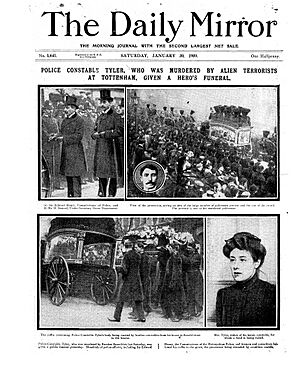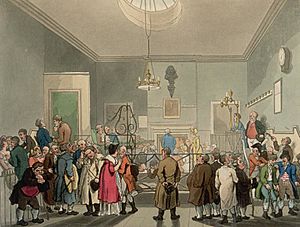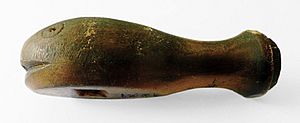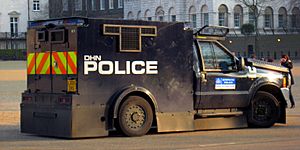History of the Metropolitan Police facts for kids
The history of the Metropolitan Police in London is a long and interesting story. It covers many events from when it started in 1829 right up to today.
Contents
Early Policing in London
Before 1829, London didn't have a proper police force. Law enforcement was handled by unpaid parish constables. These were local people chosen to keep the peace. If there was big trouble, like riots, the army would step in.
In 1753, a writer named Henry Fielding, who was also a judge, created the first detective group. They were called the Bow Street Runners. These eight constables investigated crimes and helped the volunteer watchmen. They carried a special staff with a crown on it to show who they were. Later, the Bow Street Horse Patrol started, which was the first uniformed police in London.
In 1798, the Marine Police Force was created. This group focused on stopping theft on the River Thames and around the docks. They are often seen as the world's first modern police force because they worked to prevent crime and were not controlled by the government. They were very successful, catching many thieves in their first year.
Birth of the Modern Police Force
London grew a lot during the Industrial Revolution. It became clear that the old system of volunteer constables wasn't working well enough to stop crime. So, in 1822, Sir Robert Peel, who was in charge of home affairs, decided to create a new police force.
He believed that policing should be a paid job, organized like a civilian group, and answerable to the public. His idea became law with the Metropolitan Police Act 1829. This law put London's policing directly under Sir Robert Peel's control.
Sir Charles Rowan and Sir Richard Mayne became the first leaders, called Commissioners. Their main office was at 4 Whitehall Place, with a back entrance on Great Scotland Yard. Soon, "Scotland Yard" became the famous name for the force.
Peel wanted the police to look friendly, not like soldiers. Their uniforms were blue, not red (which was a military color). They carried only a wooden truncheon and a rattle to call for help. They even wore top hats until 1864! Their ranks didn't use military titles, except for Sergeant. Officers earned about one guinea (£1.05) a week. They worked 12-hour shifts, six days a week.
The police usually didn't carry guns. However, Sir Robert Peel allowed them to buy 50 small pistols for very serious situations, like when criminals had firearms.
The 19th Century Police
Early Years: 1829-1859
The first Metropolitan Police officers started patrolling on 29 September 1829. Some people didn't like them at first, seeing them as a threat to their freedom. The force began with two Commissioners, eight Superintendents, 20 Inspectors, 88 Sergeants, and 895 Constables. They patrolled within about 11 kilometers of Charing Cross.
Between 1829 and 1830, 17 local police areas, called divisions, were set up. Each had a letter, like A (Whitehall) or F (Covent Garden).
Sadly, on 28 June 1830, Constable Joseph Grantham was the first officer killed while on duty. People sometimes called the police names like 'Raw Lobsters' or 'Peel's Bloody Gang'. Officers were often attacked.
One of the police's main jobs was keeping public order. They helped control large protests, like the Chartist demonstrations. In emergencies, ordinary citizens could be appointed as temporary police officers, called Special Constables.
In 1839, the police area grew to 15 miles from Charing Cross. The Bow Street Runners and Horse Patrol joined the Metropolitan Police. The City of London Police also started as a separate force. The River Police joined too, becoming the Thames Division, covering the River Thames.
The Metropolitan Police didn't have detectives at first. But in 1842, they formed the "Detective Branch." It had two Inspectors and six Sergeants. One of their first big cases was the "Bermondsey Horror" in 1849, where a couple murdered someone and buried the body. The detectives tracked them down.
Later Years: 1860-1899
From 1860, the Metropolitan Police also policed Royal Dockyards like Portsmouth and Chatham. It took time for the force to become well-disciplined. There was a police strike in 1872. In 1877, some high-ranking detectives were accused of corruption. Because of this, the Detective Branch was reorganized in 1878 and renamed the Criminal Investigation Department (CID).
After some officers were killed by firearms, the police were allowed to carry revolvers in outer areas. This was only if their senior officer trusted them to use it safely. Most of this system ended by the late 1800s. The old flintlock pistols were replaced with newer revolvers.
In 1883, the police started using "police whistles" instead of rattles to call for help. They also got new, stronger truncheons. Important cases during this time included the Whitechapel murders (1888), which involved the famous Jack the Ripper.
In 1883, a special group called the Special Irish Branch was formed to fight Irish terrorism. Later, it became simply Special Branch, dealing with other threats too. The police also continued to manage protests, like the "Bloody Sunday" demonstration in 1887.
The 20th Century Police
Early 1900s: 1900-1918
By 1900, the police force had nearly 16,000 officers. Crime detection improved greatly when Sir Edward Henry set up a Fingerprint Bureau at Scotland Yard in 1901. This was based on earlier work in India. The first murder conviction in the UK using fingerprint evidence happened in 1905. Another famous case was the investigation into the murderer Hawley Harvey Crippen in 1910.

Two robberies by anarchists led to a debate about arming the police. In 1909, during the Tottenham Outrage, officers borrowed guns from people nearby, and one officer was killed. In 1910, three police officers were murdered in Houndsditch, leading to the Siege of Sidney Street. After this, the Metropolitan Police bought a thousand self-loading pistols.
During World War One, volunteer groups like the Women's Police Service helped the police, but they weren't official members. Concerns about pay led many officers to go on strike in 1918 and 1919.
After the Wars: 1919-1929
Female police officers officially joined the Metropolitan Police in February 1919. They were called "Woman Police Constable" (WPC) and "Woman Police Sergeant" (WPS). Sofia Stanley led them and designed their first uniform. Their duties included patrolling and helping with female and young detainees. They could observe crimes but had to call male colleagues to make arrests. They weren't allowed to carry handcuffs unless told to.
In 1923, there was an attempt to get rid of female officers to save money. Sofia Stanley fought this, and a small group of twenty female officers remained. After a new law, they were given the power to arrest for the first time. However, a rule was introduced in 1927 that women had to leave the police if they got married.
Changes in the 1930s
In 1931, Lord Trenchard became the Police Commissioner. He made several changes, including setting up the Hendon Police College. This college trained junior officers for higher ranks.
Trenchard also gave the special constables their current name, the Metropolitan Special Constabulary (MSC), in 1934. They were given armbands, a truncheon, and a whistle instead of full uniforms. He also made sure that pistols were issued to police stations based on their size. In 1937, female officers were allowed to take fingerprints for the first time.
World War II: 1939-1945
When World War Two started in 1939, the Metropolitan Police was short of officers. To help, ex-police officers rejoined, and many Special Constables and War Reserve Constables served full-time. Crime rates in London went up during the war, with looting and black market sales.
The police also had new responsibilities, like providing armed protection against sabotage and helping the military if there was an invasion. They received thousands of rifles from the army for these roles.
Post-War Period: 1945-1959
Crime continued to rise after the war. By 1948, the number of recorded crimes in London had increased tenfold. The rule that female officers had to leave if they married was permanently removed in 1946.
In 1952, a police officer was killed during a break-in in Croydon. This led to a famous case involving Derek Bentley. After this, many police firearms were found to be faulty, leading to new pistols being bought for specialist officers. In the 1950s, the first female officers received medals for their bravery.
Since 1951, police officers in the UK can receive the Police Long Service and Good Conduct Medal after 20 years of service.
Modern Times: 1960-1978
In 1965, the Special Patrol Group (SPG) was formed. These officers received special training for public order duties. From 1973, the Metropolitan Police also dealt with many bombings by the Provisional IRA. This included the Balcombe Street Siege in 1975, where IRA members took hostages.
In 1971, Karpal Kaur Sandhu became Britain's first female Asian police officer. In 1973, the separate Women's Department was fully joined into the Metropolitan Police. Female officers did not get equal pay with male officers until 1974.
The 1970s also saw accusations of institutional racism against the police. For example, the Notting Hill Carnival disturbances in 1976, where officers clashed with protesters. An investigation in the late 1970s found corruption at many levels within the force.
Challenges and Changes: 1979-1985
In 1979, a teacher named Blair Peach died during a protest. It was claimed he was hit by a police radio. This and other accusations of brutality led to the SPG being replaced by the Territorial Support Group in 1986.
In 1979, Nicola Grey became the Met's first female dog handler. The Met was also involved in the Iranian Embassy siege in 1980, though the army's SAS eventually stormed the building.
In the early 1980s, the police used a controversial law to stop people on the street, which caused tension. This led to severe rioting in Brixton in 1981. A report later said the police had problems with racial discrimination.
In 1983, officers arrested serial killer Dennis Nilsen. In 1984, WPC Yvonne Fletcher was murdered outside the Libyan Embassy. More riots broke out in Brixton and Tottenham in 1985, where PC Keith Blakelock was murdered.
Late 20th Century: 1986-1999
The police worked on major cases like the conviction of Kenneth Erskine for attacks on elderly people. The unsolved murder of Daniel Morgan in 1987 has been linked to claims of police corruption. A 2021 report called the Metropolitan Police "institutionally corrupt" in its handling of this case.
In 1989, the official name changed from "Metropolitan Police" to "Metropolitan Police Service." The Service also dealt with the Poll tax riots in 1990.
From 1993, several investigations failed to convict the murderers of Stephen Lawrence. The resulting MacPherson inquiry found that the Met was "institutionally racist." This led to a third Brixton riot in 1995.
In 1999, the prefix "Woman" was dropped from female officers' ranks. The Macpherson Report confirmed that institutional racism existed in the service. Also in 1999, the police area was made the same as Greater London.
The 21st Century Police
Early 2000s: 2000-2009
From 2000, the Greater London Authority started overseeing the police force. The Thames Division was renamed the Marine Policing Unit in 2008.
In 2001, the police used "kettling" to control crowds during a protest, which meant holding people in one area for a long time. An internal report in 2002 found that criminals could bribe corrupt officers at Scotland Yard.
The Metropolitan Police played a big role after the 7 July 2005 bombings. Two weeks later, officers mistakenly shot and killed Jean Charles de Menezes, thinking he was a terrorist. In 2006, officers stopped a Transatlantic aircraft bomb plot. They also defused two car bombs in central London in 2007.
A review of Stephen Lawrence's murder in 2007 led to the conviction of two men in 2012. In 2008, the National Black Police Association boycotted the Met due to racism allegations. The Met used "kettling" again during the 2009 G20 London summit protests, where a bystander died after being pushed by an officer.
Recent Years: 2010-2019
The Met managed security for Pope Benedict XVI's 2010 visit. In 2011, many people were arrested during a large anti-cuts protest in London. The police also solved the "Night Stalker" case, convicting Delroy Grant for attacks on elderly victims.
About 5,000 officers policed the wedding of Prince William and Kate Middleton in 2011. Later that year, the shooting of Mark Duggan by police led to widespread riots across London. The Met also helped investigate the disappearance of Madeleine McCann.
The 2012 Summer Olympics involved the largest police deployment in UK history, with up to 10,500 Met officers.
In 2015, it was revealed that the police had spied on several politicians. In 2017, the Met said it might not investigate low-level crimes due to budget cuts. That same year, Cressida Dick became the first female Commissioner of the Metropolitan Police Service.
The Met was involved in countering and investigating terror attacks in Westminster and on London Bridge in 2017. They also helped protect firefighters during the Grenfell Tower fire and led a big investigation into its cause. In 2018, they investigated a chemical agent incident in Salisbury.
The 2020s
In March 2021, Sarah Everard was kidnapped and murdered by a serving Met police officer, Wayne Couzens. The Met faced criticism for their handling of a vigil for Sarah Everard, which turned into a protest. A report found their actions were "justified" due to COVID-19 rules, but also called their response a "public relations disaster."
In June 2021, a report on the 1987 murder of Daniel Morgan called the Metropolitan Police "institutionally corrupt" and criticized the Commissioner. In March 2022, another report criticized the Met's measures to fight corruption, suggesting "indifference to the risk of corruption."
Images for kids
See also
- Bow Street Police Museum
- Crime Museum
- Metropolitan Police Museum
- History of criminal justice § Modern police
- History of law enforcement in the United Kingdom
- List of medals awarded to Metropolitan Police officers















